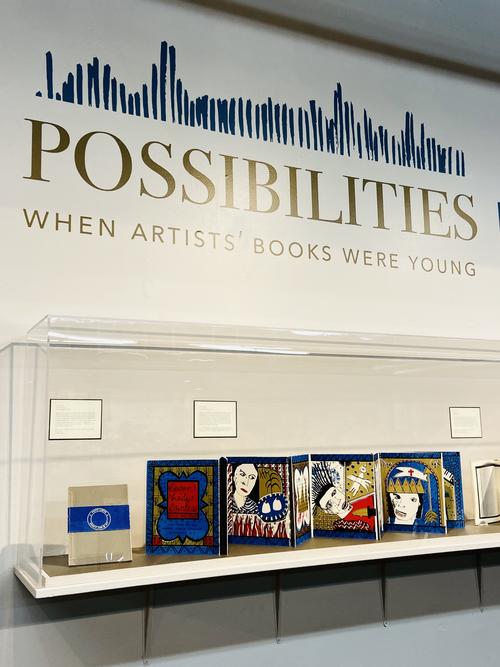
The San Francisco Center for the Book (SFCB) is a magically inspiring art haven that’s often overlooked in the city. Whether or not you’ve been there before, their current exhibit, Possibilities: When Artists' Books Were Young, presents the perfect opportunity to visit now. It is a collection of artists’ books by women, including women of color, produced primarily in the 1970s - 1990s. By placing these books front and center in their own spotlight, this exhibit showcases the voices of women artists, the great range of artist book types, and the many issues that women/humans care about in the world. It’s a timely, poignant, powerful exhibit held in a unique venue.
What Are Artists’ Books?
SFCB celebrates the art of the book, an art form that’s frequently overlooked and undervalued. In fact, when SFCB opened 25 years ago, it was the first of its kind on the West Coast, and it remains one of just a handful of venues dedicated to this niche format.
Artists’ books draw inspiration from the form and function of books, but are created specifically through an artistic lens. Some of these books look almost like any other book that you might find on a library shelf, except that they’re handmade, printed uniquely, or contain primarily or only artistic images within the pages rather than text. On the other hand, some of these books are so unique in their binding, shape, dimension, and printing that they almost don’t look like “books” at all.
What’s wonderful about the Possibilities exhibit is that the books run the gamut of these formats, allowing people new to the form to truly experience the immense creativity that goes into these works of art and the infinite possibilities inherent to the medium. There are accordion books, foamcore books, books with silk binding…the list goes on.
Examples from Possibilities
You truly need to see the exhibit for yourself to grasp this range of styles. However, here are a few examples to give you a starting sense of what you might see when you visit:
“La Promenade en ville” by Warja Lavater
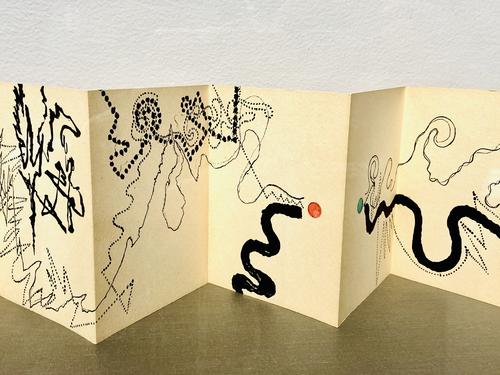
This is actually the oldest book in the exhibit, created in 1962 using lithography and utilizing an accordion fold structure. The book contains five different characters whose stories both diverge and intersect. However, the story is told entirely in symbols of dots and lines and color, so you might not be able to understand the narrative as much as feel the emotion inherent in the visual story.
“Perspectives VIII: Coral Reef” by Joan Lyons
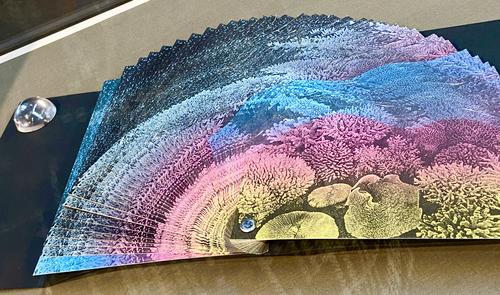
This 1977-78 work is boldly full color printed offset on uncoated paper. The artists took images from 19th century lantern slides, printing them repetitiously, stacking them, and cutting them, thus creating a new work of art from an existing image. We see many different binding styles across artists’ books, yet this one is especially unique in that the colorful pages are encased in black folders but only bound at a single point so that the entire book can fan out. It’s this attention to form that often makes artists’ books different from “regular” books, with or without text.
“Silk and Secrecy” by Jumi Korf and Emoretta Yang
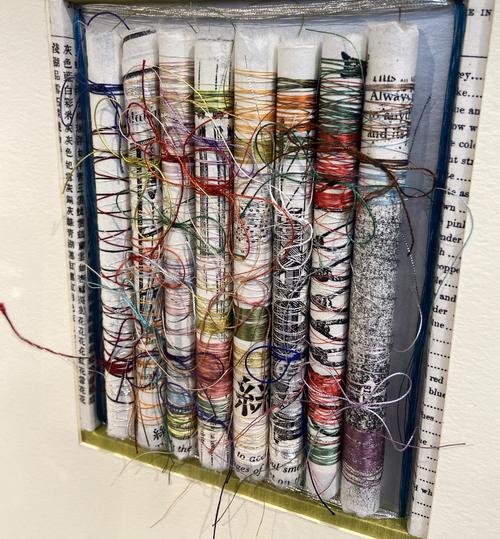
This 1985 piece looks like an oversized bound book, but on the inside are hidden cutouts. In one is a series of scrolls with the “secrets” written on them. These scrolls are bound with beautiful, vibrantly colored silk thread. If you wanted to read the story on the scrolls, you’d have to destroy the art. In terms of materials, this one not only includes silk but also museum board, Japanese paper, printed paper, bookcloth and foamcore. It uses both hinge binding and pamphlet stitch, and is a brilliant example of how many different materials and binding options there are in the book arts.
“What’s Happening With Momma?” by Clarissa Sligh
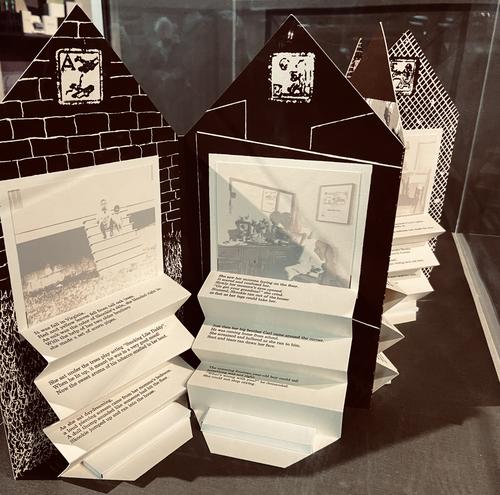
This 1988 work is one of the most book-like works here, in that it tells a entire clear story through text. And yet, it is shaped like a house and crafted using silkscreen and letterpress on cardboard, so it also looks less like a traditional book than many other pieces in the exhibit. Sligh combines blurry photographic images with fold-out, three-dimensional steps where the text tells the story of how horrifying it was to her to be a young child while her mother went through a home birth.
The SFCB website page for the exhibition has links to many of the artists’ websites.
History of Women in the Book Arts
The title of this exhibit, you’ll recall, is Possibilities: When Artists' Books Were Young. Of course, in a sense, artists’ books have existed since art and text could be combined. However, this exhibit looks specifically at a pivotal point in women’s book art history: the 1970’s - 1990’s.
If you’re up to date on the relationship between second-wave feminism and American art history, then you know that the 1970s were a rich time for women as they fought for equal representation in galleries and exhibits. They demanded recognition as artists across all mediums, as well as for a celebration of “crafts” and art forms that were traditionally thought of as female, and therefore lesser-than so-called "fine art."
Artists’ books were one of these mediums. On one hand, it was easy and relatively inexpensive to begin to work in the book arts, and yet books as a format tend to evoke ideas of knowledge, wisdom, and authority. Therefore, artists’ books were an accessible yet confidence-projecting art form perfectly well-suited to the late twentieth century. The artists’ books created by women during this time period are historically significant and shockingly powerful to behold in person in their original printing.
Diversity of Women in the Book Arts
Of course, second wave feminism had its flaws and shortcomings. One of those was a lack of diversity. It was, for the most part, a white woman’s movement. And that was true in the book arts aspect of this history as well. However, women of color worked to correct this. In the late 1980’s, artists Faith Ringgold and Clarissa Sligh created a four-exhibition initiative called Coast to Coast: A National Women of Color Artists’ Book Project, featuring the work of nearly 150 women artists of color.
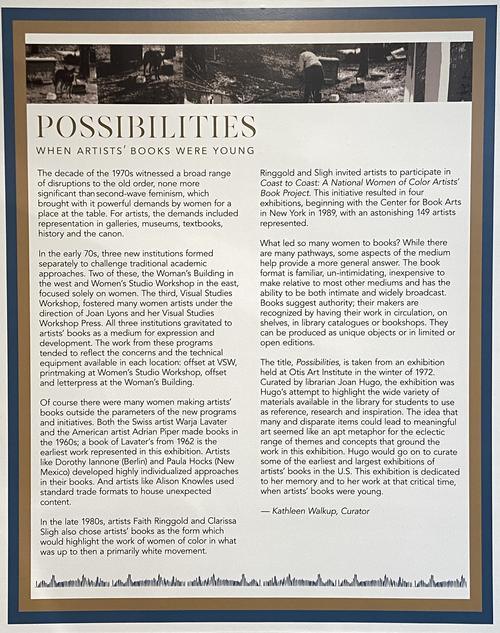 Several of these artists are represented in the Possibilities exhibition, as is the poster for the original initiative, which includes images from 11 of the artists on it along with their signatures. Another poster you’ll see in the exhibition is for the original Possibilities exhibition from which this one draws its name. That was a 1972 Otis Art Institute exhibition in which librarian Joan Hugo, a historic curator of artists’ book exhibits, aimed to celebrate how all of the different materials in a library could inspire art.
Several of these artists are represented in the Possibilities exhibition, as is the poster for the original initiative, which includes images from 11 of the artists on it along with their signatures. Another poster you’ll see in the exhibition is for the original Possibilities exhibition from which this one draws its name. That was a 1972 Otis Art Institute exhibition in which librarian Joan Hugo, a historic curator of artists’ book exhibits, aimed to celebrate how all of the different materials in a library could inspire art.
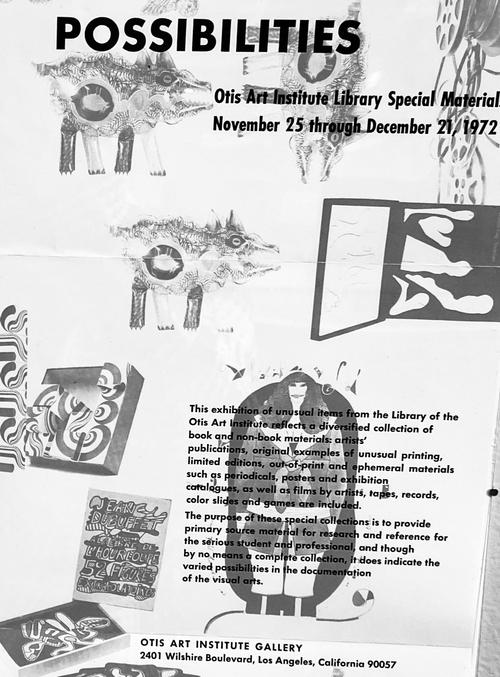
Curator Kathleen Walkup strived intentionally to represent a diverse array of women’s voices in this exhibit. The plans for the show began before COVID and she originally intended to include over 100 different artists in the show, which was intended to travel to three total venues. The pandemic changed those plans, but as she refined her list of artists’ books to include in this single-venue show, she chose to emphasize racial diversity of the artists, a spectrum of designs from high-concept to material-focused, and inclusion of works less likely to be seen in other shows.
The Personal Is Political
There are so many thought-provoking personal pieces in this exhibition, speaking to the socio-political and cultural issues that the women artists grappled with as they created this work.
One of the most powerful pieces in the collection is a small square book called “Rape Is.” The book is displayed open to a page that reads simply, “Rape is … when you are hitchhiking and he therefore infers you are asking for it.” This 1972 artists’ book by Suzanne Lacy uses the style of the then-quite-popular Charles Schultz book “Happiness Is a Warm Puppy,” to confront the systemic societal issue of rape.
Meeting The Challenge of Exhibiting Artists’ Books
We only get to see the cover and one page of the “Rape Is” book. One of the biggest challenges of an exhibit of artists’ books is coming up with a way to display the books so that as much of each book can be seen while still protecting the books to preserve them over time.
In the Possibilities exhibit, most of the books are displayed underneath cases. Obviously, visitors can’t be allowed to handle the pages of these books that are a crucial part of art history and already decades old. It’s challenging for the visiting book lover because books are such a tactile thing, even in this era of Kindle.
The SFCB team and curator Kathleen Walkup worked hard to offer the best possible display of the work. Some books are spread out so that we can see multiple pages. One accordion book (“La Promenade en ville” by Warja Lavater) is open to its full length while another (“Seven Lady Saintes” by Erica Van Horn) is open in large part. Books are housed in such a way that you can walk 360 degrees around them. One book,“A Motherhood and Notebook” by Terry Braunstein, is a 3D binder, a sort of scrapbook about early motherhood, that’s interactive and allowed to be flipped through. Each piece includes a descriptive narrative beneath it to help with better understanding the content inside the book.
On the wall is a video that shows the books that are on display. Through this video, we are able to see more pages from each of the books than are already visible in the exhibit. It’s not a perfect solution, but it adds to the overall experience. SFCB is also releasing a full-color 140+ page exhibition catalog soon that includes additional excerpts from the books alongside essays from some of the artists.
Possibilities is on exhibit at San Francisco Center for the Book through Sunday, May 1, 2022. The gallery is open Wednesday through Friday from 10-5 and weekends from 12 - 4. On March 24th attend a virtual conversation with e bond and Clarissa Sligh about the exhibit. On May 1, attend a very unique potluck closing reception inspired by Alison Knowles’ Journal of the Identical Lunch.
If you’ve never visited before, the SFCB is located in the Do.Re.Mi (DOgpatch-PotREro-Hill-MIssion) Design and Arts District. The exhibit is on one side, and you’ll get a chance to see some of the printing machinery on the other side. The building is bigger than you might think with a full book bindery and an arts and craft room behind closed doors. Artists can take a range of different book arts classes and workshops in this space.
Comments (9)

I've been a SFCB member for many years now and they always have such great shows. Wish they could get the funds for a larger space, but I haven't hit the lottery yet!

There are a lot of wonderful books in this show!

I read every single page in this exhibition, loved it!

I am very glad to read this informative article.

I love seeing books as artwork.

Fascinating show, so happy I managed to see it.

I can't wait to get this catalogue!

Dear Kathryn, Huge thanks for this terrific review! I am very appreciative and of course delighted you like the show. 144-page catalogue coming soon!
Best, Kathleen Walkup










I love the SFCB shows! Their classes are even more fun.